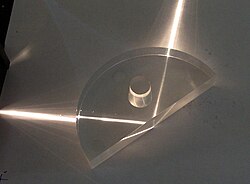Optics/Total internal reflection
Total internal reflection is a phenomenon that occurs when light travels from a more optically dense medium (or a medium with higher refractive index ) to a less optically dense one (lower index ), such as glass to air or water to air. When light travels from an optically dense medium to a less optically dense medium, the light refracts away from the normal. If the angle of incidence is gradually increased, one will notice that at a certain point, the refracted ray deviates so far away from the normal that it reflects rather than refracts. This results whenever the refracted angle predicted by Snell's Law becomes greater than 90 degrees.

The critical angle is defined as the angle of incidence (inside the higher-index material) for which Snell's Law predicts a 90-degree angle of refraction -- this would mean the light follows the surface rather than entering the low-index material.
One can calculate the critical angle using Snell's Law:
Total internal reflection will occur for any incident angle greater than θc.
Because the reflected ray never leaves the higher-index material, Snell's Law for total internal reflection becomes , in other words , which is the law of reflection.
There is always a fraction of the energy reflected at a boundary between materials of different refractive index, but it is usually quite small (typically a few percent). In the case of total internal reflection, however, 100% of the beam energy reflects (hence the name "total").
You can easily observe total internal reflection for yourself next time you are in a swimming pool. If you are under water looking up, you see the sky. As you turn your head to look closer to horizontal, you see a reflection of the bottom (or side) of the pool. These rays from the pool bottom hit the water-to-air boundary at an angle of incidence greater than the critical angle, so they are reflected to you.
How do I know that the reflected ray isn't just the refracted ray? The second law of reflection states that "the incident ray, the reflected ray, and the normal are coplanar." Therefore, the refracted ray must be in the second medium. If it is in the same medium that it originated from, then it is the reflected ray. The reflected angle is also the same as the incident angle, which agrees with the first law of reflection.








